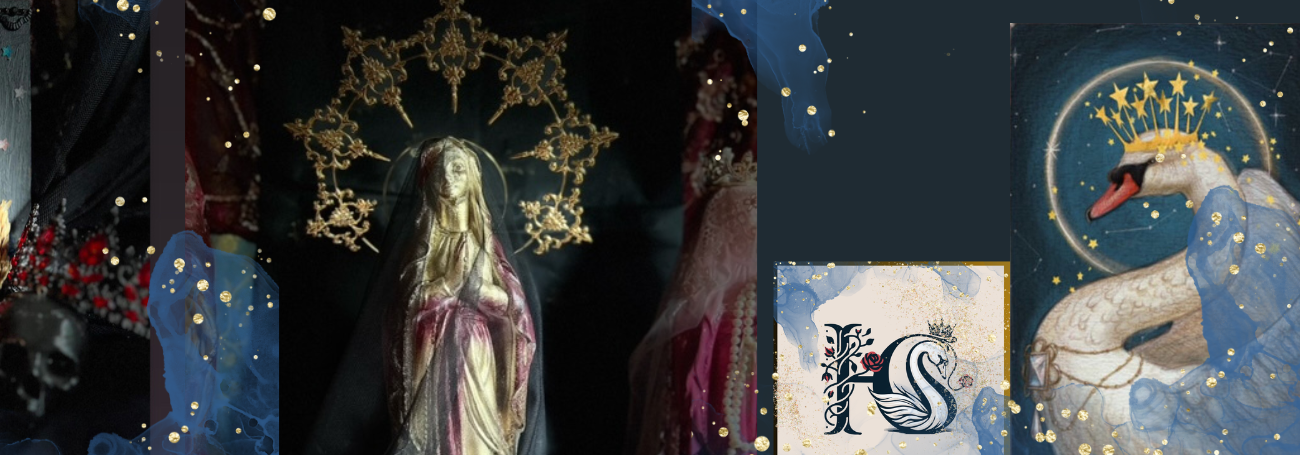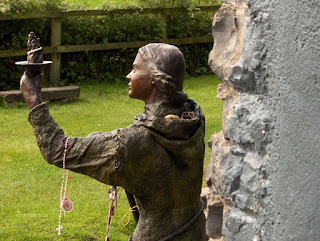SHE
Beckoning, calling
A beacon of light in the darkness.
Winds swirling, moving white light blending with white cloth.
A smile, a halo, hair or light?
She is calling, walking ahead, leading, guiding, gently shining
the Light.
I follow, one foot forward, then another,
tentatively, unsure, until finally,
breaking out in a run,
feet secure, heart pounding,
following blindly,
following Her. – Hettienne Bhaktymayi Maria Ma – 2004

The year after I found Mary’s Well in
Glastonbury, I attended the International Goddess Conference in Glastonbury – the first of many to follow. That year the focus was on Bridie or Brigid and her swan.
If you have been following the story, you will know that Hestea/Vesta led me to St Brigit and Michael’s Tower in Glastonbury.
I stayed in the same bed n breakfast as before and this time I shared the space with Sister Mary McAleese, a Brigidine nun from Kildare!
From her I learnt that Brigit is also known as Brede or Mary of the Gael! You may remember my mention of the one book that made such an incredible impact on my life. I read ‘In this House of Brede’ by Rumer Godden when I was fourteen – I still own that copy. I have given many books away since, but never that one. I could not explain to you why the book was so important, other than that I always felt that there was a story behind the words that only I could ‘see’.
When those nuns told me that Brede was St Brigit, the key fitted the door and the following year I travelled to Kildare, Ireland to the sanctuary of St Brigit, Mary of the Gael.
The nuns are Brigidine nuns, living in Kildare in Ireland. They are part of a community known as Solas Brihde, devoted to the all-encompassing Celtic St Brigit : saint, poetess, protector and healer.
They have restored the original Brigit sacred pilgrimage site along with a small publication, guiding pilgrims in the power and symbolism of the pilgrimage to Brigit.
The original site dedicated to Brigit, Celtic Goddess, is still to be seen in the grounds of the Catholic Church
erected on the same site.

This shrine, near Kildare, was located near an ancient Oak that was considered to be sacred by the Druids, so sacred in fact that no one was allowed to bring a weapon there.
The shrine is believed to have been an ancient college of priestesses who were committed to thirty years of service, after which they were free to leave and marry.
During their first ten years they received training, the next ten were spent tending the sacred wells, groves and hills of the goddess Brigid, and the last decade was spent in teaching others.
Nineteen priestesses were assigned to tend the perpetual flame of the sacred fire of Brigid. Each was assigned to keep the flames alive for one day. On the twentieth day, the goddess Brigid herself kept the fire burning brightly.
The goddess Brigid was also revered as the Irish goddess of poetry and song. Known for her hospitality to poets, musicians, and scholars, she is known as the Irish muse of poetry.
The Feast Day of Brigid, known as Imbolc, is celebrated at the start of February, midway through the winter. Like the goddess herself, it is meant to give us hope, to remind us that spring is on its way.
The lessons of this complex and widely beloved goddess are many.
The Celtic goddess Brigid lends us her creativity and inspiration, but also reminds us to keep our traditions alive and whole. These are gifts that can sustain us through any circumstance.
Her fire is the spark of life. – taken from local literature.

Lighting the Perpetual Flame – A Brief history
A sacred fire burned in Kildare reaching back into pre-Christian times. Scholars suggest that priestesses used to gather on the hill of Kildare to tend their ritual fires while invoking a goddess named Brigid to protect their herds and to provide a fruitful harvest.
When St. Brigid built her monastery and church in Kildare she continued the custom of keeping the fire alight. For her and her nuns the fire represented the new light of Christianity, which reached our shores early in the fifth century.
Gerald of Wales (Giraldus Cambrensis) a Welsh Chronicler, visited Kildare in the twelfth century, he reported that the fire of St. Brigid was still burning in Kildare and that it was being tended by nuns of St. Brigid. Some historians record that a few attempts were made to have the fire extinguished but without success. It survived possibly up to the suppression of the monasteries in the sixteenth century.

The sacred fire/flame was re-lit in 1993, in the Market Square, Kildare, by Mary Teresa Cullen, the then leader of the Brigidine Sisters, at the opening of a justice and peace conference. The conference, entitled “Brigid: Prophetess, Earthwoman, Peacemaker” was organised by Afri, (Action from Ireland), a justice, peace and human rights organisation, to celebrate the tenth anniversary of St. Brigid’s Peace Cross Project. Since then, the Brigidine Sisters in Kildare have tended the flame in their Centre, Solas Bhride.
Kildare County Council commissioned a sculpture to house the flame in Kildare Town Square in 2005. The piece comprises a twisted column, which flourishes at the top into large-scale oak leaves, nestled into which there is a bronze, acorn cup holding the flame. The use of oak leaves symbolises both the Christian beliefs of St. Brigid and the earlier Druidic worship of the trees. Of course, the oak is also the namesake of Kildare, Cill Dara, Church of the Oak.
President Mary McAleese presided at the lighting of the Perpetual Flame in the Town Square on Feb.1st St. Brigid’s Day 2006. The flame was lit from the flame tended by the Brigidine Sisters in Solas Bhride. The flame burns as a beacon of hope, justice and peace for our country and our world. We still tend the flame in Solas Bhride. – extracted from www.solasbrihde.ie
I would like to quote from Riane Eisler’s Sacred Pleasure, Sex, Myth and the Politics – New Paths to Power and Love :
From the Sacred Marriage of the Goddess to Male Brides of God. In conformity with male dominator systems’ requirements, this tenet that woman is inferior to man pervades many mystical writings, both Eastern and Western. …inner contradictions also characterize most Judeo-Christian mystical writings. For in these monotheistic religions the female is deprived of all divine power, which is presented exclusively in male form. Yet, even despite such radical remything, there are still in the Bible many traces of both the Goddess and her sacred marriage, confirming the archeological evidence that Goddess worship (and with this sacral sex) continued to flourish in Canaan. For instance, Hebrew prophets are cosntantly exhorting their people against backsliding to the worship of the Queen of Heaven, railing against the ‘whore of Babylon’ and the sinful ‘daughters of Zion’. The Christian veneration of the Virgin Mary is a directly traceable to the ancient worship of the Goddess. And so also are a number of well-known Catholic saints, as it is to the Church’s co-option of earlier pagan deities that many Christian saints owe their origins. A well-documented example is the famous Irish Saint Brigit, who owed her great popularity to the fact that she was once the powerful Irish Goddess Brigit.


